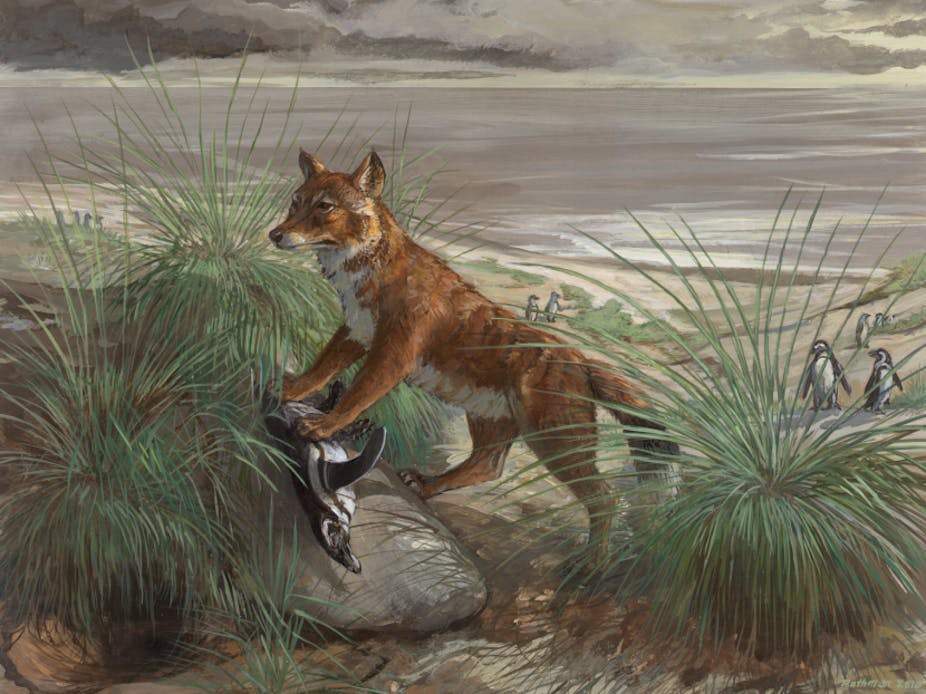A long-standing natural history mystery has been solved, as my colleagues and I explain today in the journal Nature Communications.
The Falkland Islands wolf, or warrah, may have been the world’s loneliest land mammal. It was marooned for thousands of years on the wind-swept Falkland Islands with only seabirds, penguins and seals for company.
These animals represented an enigma to early explorers, scientists and natural historians. Charles Darwin, the father of the theory of evolution, visited the islands in 1834 and mused on the origins of this odd creature.
How did a medium-sized mammal make the 460km journey from the South American mainland, and why was it the only land mammal to have done so?
Sadly, like the Dodo and Tasmanian tiger, the Falkland Islands wolf was hunted to extinction within 200 years of discovery. The last animal was killed 40 years after Darwin’s visit to the islands taking the secret of its origins with it. In the 130 years since, the origins of the Falkland Islands wolf have been a mystery, providing many more questions than answers:
- Did the ancestor of the warrah make a miraculous sea journey on ice floes or rafts of vegetation blown off the South American mainland by the prevailing westerly winds?
- Did it walk there via a land-bridge during lowered sea levels in ice ages?
- Was it carried there as a semi-domesticated companion/hunting animal by the first human occupants of southern South America, some time in the last 10,000 years?

Cracking the riddle
In our Nature Communications paper, myself and colleagues from the University of Adelaide (Alan Cooper, Julien Soubrier), Argentina (Fancisco Prevosti, Luciano Prates, Valentina Trejo), and Chile (Franciso Mena) detail the work we did.
We pieced together the puzzle using new data from genetics, fossils and oceanography and discovered the ancestor of the warrah probably walked to the islands across a frozen, narrow marine strait during the last ice age, about 16,000 years ago.
Working in our specialist, ultra-clean-room ancient DNA laboratory we carefully extracted DNA from museum specimens of the Falkland Islands wolf and subfossil bones of an extinct South American wolf.
The extinct mainland wolf provided the first key to solving the riddle. Without these samples from the most-likely mainland source population it’s almost impossible to say anything about the origin of the island species.
Using DNA from these two extinct species we were able to show they were very closely related. Determining how close was the key to identifying when the ancestor of the warrah reached the Falkland Islands.
Using new mathematical techniques to estimate a “molecular clock” we calculated the age of the split between the mainland fox and the warrah to be around 16,000 years ago, much more recently than previously thought.
Importantly, this date is before the arrival of humans in South America, some 12,000 years ago. If humans didn’t carry the ancestor of the warrah to the islands, how did it, and only it, make this long voyage across inhospitable oceans?

Thanks to new oceanographic information, we know the Falkland Islands weren’t always as isolated from South America as they are today. At the height of the last ice age sea levels were up to 130-150 metres lower, exposing an enormous coastal plain off the Argentine coast.

The Falkland Islands also quadrupled in size. As a result the marine strait separating the two shrank dramatically, potentially to just 20-30 km. The remaining stretch of water would also have been much shallower.
It seems likely that under the cold conditions of the last ice age this strait could have periodically frozen over, creating a brief window of opportunity for a cunning fox to reach new land.
The absence of any other land mammals on the Falkland Islands suggests the connection with the mainland must have been brief and relatively inhospitable. Acting as a filter, rather than a corridor, periodic icy connections would have discouraged dispersal by most land mammals, leaving the Falkland Islands wolf “home alone”.
Of course, the warrah’s 16,000 year isolation contributed to its eventual demise. Like many island species, it was totally naive to predators - including humans - and was easily killed by early European settlers.
For the warrah, the Falkland Islands turned from an ark to an executioners chamber in less than 200 years.

